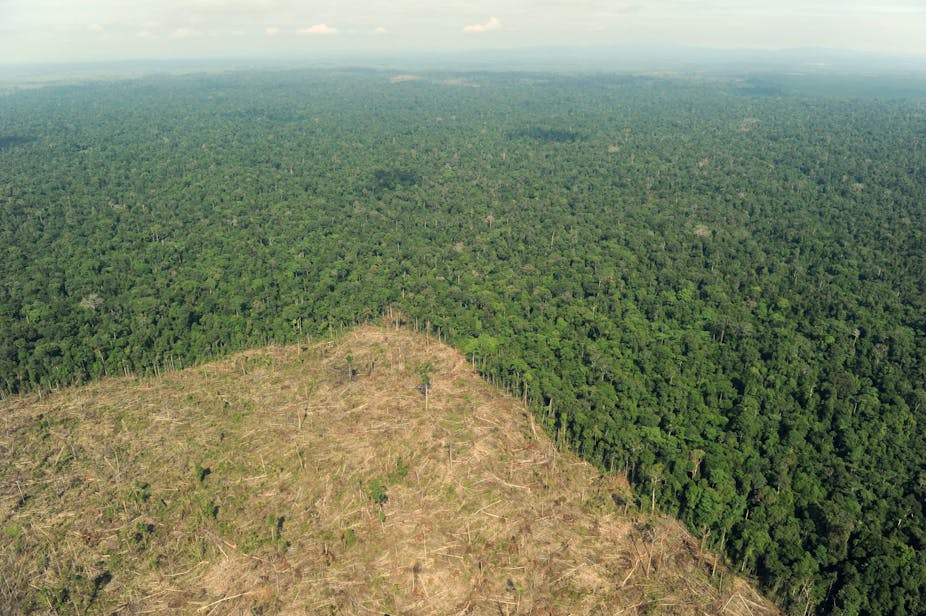The world has been fiddling while the forests burn, or are otherwise lost. One proposal to keep what’s left intact is REDD – essentially, paying countries to conserve their forest carbon stocks.
REDD (Reducing Emissions from Deforestation and forest Degradation) has rocketed through the generally tortuous international climate change negotiations since it was proposed by the “Rainforest Nations” in 2005.
It was also among the few points of agreement at the otherwise disappointing 2009 UN Copenhagen Climate Change Conference.
REDD and its successor REDD+ (REDD plus measures to enhance forest carbon stocks) were given further momentum at the 2010 UN Cancun Climate Change Conference. The conference formally adopted REDD+ and established a Green Climate Fund to support its implementation.
In the meantime, Norway has been very active in promoting REDD-related activities, which have led to agreements with a number of tropical countries to stop deforestation. Indonesia is the most recent and significant of these.
Why do we need REDD+?
REDD+ is appealing for many reasons.
The longest-standing is the imperative for more effective biodiversity conservation, particularly in the tropical forests that contain between one-half and two-thirds of all terrestrial biodiversity. Many conservation biologists believe an extinction crisis is looming in these forests.
Those concerned with forest conservation and more sustainable forest management have been trying since before the 1992 Rio Earth Summit to arrest deforestation.
Notwithstanding some notable successes, such as recent reductions in Amazonian deforestation, the global rate of forest loss have diminished only slightly over the past 20 years. It is still around 13 million ha annually (equivalent to nearly twice the area of forest in Victoria).
The second reason is the scale of greenhouse gas emissions from deforestation and forest degradation. This is currently around 15% of total emissions – more than the transport sector, or either of China’s or the USA’s annual emissions.
Most forest-based emissions come from the few, mostly tropical, countries with large areas of carbon-dense forests and high rates of deforestation. These include Brazil, the Congo, and Indonesia.
Slowing forest-based emissions delivers immediate reductions, “buying time” for other mitigation strategies to be implemented.
Since the Rio conference, many of the “developing” nations have been pointing out the economic and development implications of not exploiting their forests. If they’re not to exploit them, they want compensation.
Such an argument is hard to deny for a number of reasons. More than 1.5 billion of the world’s poorest people rely on forests for their livelihoods.
However, the world’s rich nations have not been willing to find the necessary financial resources, estimated to be at least $10-15 billion annually. Generating these funds though carbon markets is one of the few ways that they could conceivably be raised and sustained.
Whose forest is this anyway?
So REDD+ is an idea that’s gained traction quickly. It’s also generated considerable angst and, as one reviewer wrote, “a tsunami of [academic] literature”. The angst arises for a number of reasons.
The most fundamental reflects concerns about the rights of Indigenous and forest-dependent people. The state often asserts rights over their land and forests, and assigns commercial use rights to others.
Forests’ traditional owners have generally been dispossessed, excluded and marginalised. Think of Australia’s terra nullius, or the Suharto Government’s 1967 assertion of state rights over all Indonesian forests, and the concession-based plundering that followed.
Over the past decade there has been more decentralisation and devolution of rights to local communities. Many worry that REDD+ commitments will prompt national governments to reverse that trend. The money raised from REDD+ will be hard to resist.
There are many examples of how the benefits that should flow broadly to communities from managing natural capital are captured by vested interests.
Think of those who’ve become rich from the exploitation of Indonesia’s, PNG’s or the Solomon Islands’ forests, or of the capture of profits from Australia’s mineral boom.
Good on paper; how about the real world?
There are many practical concerns about implementing REDD+. What are the baselines from which REDD+ gains or losses would be assessed?
How do we monitor, verify and report changes in carbon stocks? What will that cost?
And will REDD+ simply displace deforestation to countries with the least capacity or interest to participate?
REDD+ is supposed to work as early action; part of a comprehensive mitigation strategy. But it’s possible that REDD+ will provide an excuse for inaction on the 85% of emissions that are non-forest based.
Some agriculturalists are worried that forests will displace agriculture from land, and use the water that will be needed to feed a growing world population.
Researchers have been trying to work out whether saving forests for carbon will also preserve biodiversity.
The short answer is “largely, but not completely”. Regions of high biodiversity value such as the Brazilian cerrado, mainland South East Asia, and the Southern Cape of Africa rank relatively low in terms of forest carbon stocks.
REDD+ funding could be directed to most high-priority biodiversity regions without severely reducing carbon sequestration. But non-REDD+ funding will be necessary to really protect biodiversity.
The world needs REDD+ to work. It must be made to deliver the benefits its proponents seek, without the downsides that are clearly possible.
REDD+ has been catapulted to centre-stage in climate change mitigation negotiations by an unusual conjunction of environmental, development, political, and scientific interests.
That alliance has been remarkably successful in advancing the idea of REDD+; the diverse interests it represents need to continue to work effectively together, and to find ways to properly accommodate the interests of forest-dependent peoples, if REDD+ is to live up to its promise.

